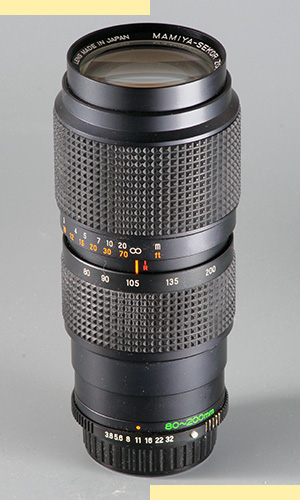The Mamiya Sekor Zoom E 3.8/80-200mm was the first zoom lens introduced for the new Sekor E mount. Its optical computation was taken over from the Sekor CS 3.8/80-200mm built for the NC1000 and NC1000S cameras. That one in turn was the successor for the earlier Sekor ES 4.5/90-230mm produced for the Mamiya XTL.
 |
MAMIYA SEKOR E 80-200mm 1:3.8 (14 lenses / 10 elements)
|
The Sekor E 3.8/80-200mm is a very well built telezoom in the common 4/80-200mm class. It's a four group zoom with a relatively modern master lens at the rear, a focusing group in front and variator and conmpensator groups in between. Its [14/10] construction is a bit more complicated than the typical [12/9]] scheme used in later 4/70-210mm lenses (e. g. the Minolta / Leica R 4/70-210mm), but clearly resembles them.
The Sekor E 3.8/80-200mm is a two-ring zoom with an MFD of 4 ft / 1.2 m. Apart from the aperture ring the entire lens is made from metal, and even after fourty years zooming and focusing is smooth and with the right amount of resistance. The aperture can be set in half-stops from f3.8 up to f32 (most contemporary zooms go to f16 or f22 only). There is however an issue with the grease used for the zomming T focusing mechanism, as several samples of the lens show weak fogging mainly in front group. More on tha later.
Around 1980, the Sekor 3.8/80-200mm was among the best telezoom lenses available. A very comprehensive test of about 25 tele zoom lenses published by German Color Foto (around 1979) gave excellnt results for the Mamiya zoom. Using todays 24 MP and 43 MP full frame cameras as a testbed, we can see that Walter E. Schön (author iof said tests) was right.
At f=80mm the Mamiya telezoom is as sharp as the Zeiss CY 4/80-200mm − and it has nearly no lateral CAs. The Mamiya remains excellent in the 80-110mm range with no visible change in resolution either wide open or at f8. Vignetting is visible, though.
At f=135mm the Mamiya starts to show some CAs, whereas the Zeiss is pretty much free from CAs. Otherwise the two lenses look nearly identical.
At f=200mm the Zeiss has a slightly better corner resolution than the Mamiya, but the diferences are surprisingly small given the fact that the Mamiya CS was introduced around 1978 and the Zeiss around 1990. And the Zeiss was much more expensive of course 8about 4x the price of the Mamiya).
CONCLUSION: At infinity, the Mamyia Sekor CS and E 3.8/80-200mm is as sharp as the highly regarded tele zoom lenses from other manufacturers such as the Canon FD 4/80-200mm, Leica R 4/79-210, the Minolta 4.5/75-200 and 4/70-210, the Nikkor Ai 4.5/80-200 (II) and AiS 4/80-200 and better than the corresponding lenses from Pentax, Yashica and Konica.
TEST Mamiya Sekor E 3.8/80-200mm vs Zeiss CY Vario-Sonnar 4/80-200mm. (corner crops from 24 MP FF Sony A7II JPGs)
Comparing a Mamiya Sekor E 3.8/80-200mm side-to-side with the Zeiss Vario-Sonnar CY 4/80-200mm, at f=80mm, 135mm, and 200mm (infinity and 24 MP FF as usual). Apertures were f3.8 (f4) and f8.
At 80mm, the Mamiya has slightly less CAs than the Zeiss, and - maybe - slightly less corner resolution. But the Mamiya looks very clean indeed.
At 135mm, both lenses look very good (for a vintage zoom, that is). Better than any vintage 2.8/135mm I'm aware of (less CAs than the Zeiss CY 2.8/135mm, MUCH better than the Leica R 2.8/135mm 2nd computation)
At 200mm and wide open, the Mamiya has different shape (narrower) and color (magenta) that Zeiss (broader, blueish). Zeiss CAs look slightly less disturbing, but Mamiya may be easier to correct in PP. Resolution of the Mamiya is as good as the Zeiss ...
And while both Mamiya versions (Sekor CS and Sekor E) have a really sturdy metal barrel, the Zeiss works smoother and feels even more precise than the Mamiyas. Zeiss has 1.0m m MFD, Sekor CS/E have 1.3m. So yes, the Mamiya certainly is a very good vintage tele zoom. In the 80-110mm range there are no CAs at all, and distortion is low around 100-120mm (barrel at 80mm, pincushion at 200mm as usual with tele zooms). BUT beware of fogging ...!!
Some samples of the Mamiya Sekor E 3.8/80-200mm have sligtly fogged front elements. This can reduce the contrast, especially in backlight situations. Cleaning the front focusing group (which consists of the tree foremost lenses: the front doublet and the single lens) is surprisingly easy.
1) Make sure you have the right tool (spanner wrench) and some solvent like acetone or (iso-)propanol
2) Soak the front ring with a few drops of solvent while turning the lens around its axis (thus ensuring that the entire ring gets some solvent); wait for maybe one minute
3) Carefully unscrew the front ring (labelled "MAMIYA-SEKOR ZOOM E 1:3.8 f=80mm ...") and remove it
4) Remove the front doublet, the spacer ring and the single positive lens of the front group (be careful to remember the correct orientation of all these parts)
5) Clean the lenses, especially the rear of the single lens and - if necessary - the front lens of the variator group which is still inside the main lens barrel
6) Re-assemble the single lens correctly. Inserting may be a little bit tricky since tolerances are small; it's best to put the single lens e. g. on a lens sucker or small rubber tube an insert it from below (!) into the inverted (!) lens barrel.
7) Inserting the spacer is no problem; and inserting the front doublet is realtively easy as well.
8) Put the front ring back into its correct postition. Done!


